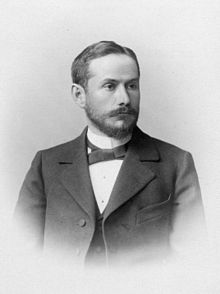Julius Tafel
Julius Tafel | |
|---|---|
 Julius Tafel | |
| Born | 2 June 1862 |
| Died | 2 September 1918 (aged 56) |
| Nationality | German |
| Alma mater | University of Munich |
| Known for | Tafel reaction Tafel equation |
| Scientific career | |
| Fields | Electrochemistry |
| Institutions | University of Munich |
| Doctoral advisor | Hermann Emil Fischer |
Julius Tafel (2 June 1862 – 2 September 1918) was a Swiss chemist and electrochemist.
Early life and education
[edit]Julius Tafel was born in the village of Choindez in Courrendlin, Switzerland on 2 June 1862. Tafel's father, Julius Tafel Sr. (1827-1893) studied chemistry in Tubingen and became a director of Von Roll’s iron and steel works located in Choindez in 1856, and then took a top management position in steel works located in Gerlafingen in 1863.[1]
Tafel attended the Realgymnasium in Stuttgart and Nuremberg, then studied chemistry from 1880 in Zurich, Munich, and Erlangen. In 1884, he earned his Ph.D. under Emil Fischer, who had joined Erlangen in 1882. Tafel followed Fischer to Würzburg in 1885 as his private assistant and completed his habilitation in 1888.[1]
Work
[edit]He worked first with Emil Fischer on the field of organic chemistry, but changed to electrochemistry after his work with Wilhelm Ostwald. He is known for the discovery of an electrosynthetic rearrangement reaction of various alkylated ethyl acetoacetates to form hydrocarbons, now called the Tafel rearrangement, and the Tafel equation, which relates the rate of an electrochemical reaction to the overpotential. He is also credited for the discovery of the catalytic mechanism of hydrogen evolution (the Tafel mechanism). Tafel retired aged 48 due to ill health but continued to write book reviews until his death.[2]
Death
[edit]Tafel suffered from insomnia and eventually had a complete nervous breakdown. He committed suicide in Munich in 1918.
References
[edit]- ^ a b "Electrochemistry Encyclopedia -- Tafel: his life and science". knowledge.electrochem.org. Retrieved 2024-09-25.
- ^ G., Compton, R. (2011). Understanding voltammetry. Banks, Craig E. (2nd ed.). London: Imperial College Press. pp. 47–49. ISBN 978-1848165861. OCLC 676743565.
{{cite book}}: CS1 maint: multiple names: authors list (link)
- Julius Tafel, Hans Hahl (1907). "Vollständige Reduktion des Benzylacetessigesters". Berichte der deutschen chemischen Gesellschaft. 40 (3): 3312–3318. doi:10.1002/cber.190704003102.
- Bruno Emmert; Stock, A. (1918). "Julius Tafel". Berichte der deutschen chemischen Gesellschaft. 51 (2): 1686–1687. doi:10.1002/cber.19180510254.
- K. Müller (1969). "Julius Tafel". J. Res. Inst. Catalysis, Hokkaido Univ. 17: 54–75.
- Julius Tafel (1905). "Julius Tafel". Z. Phys. Chem. 50: 668, 676, 689.
- G.T. Burstein (2005). "A Century of Tafel's Equation: 1905–2005 A Commemorative Issue of Corrosion Science". Corrosion Science. 47 (12): 2858–2870. doi:10.1016/j.corsci.2005.07.002.
External links
[edit] Media related to Julius Tafel at Wikimedia Commons
Media related to Julius Tafel at Wikimedia Commons- "Julius Tafel". Hebrew University of Jerusalem Institute of Chemistry. Archived from the original on 2007-12-05.
